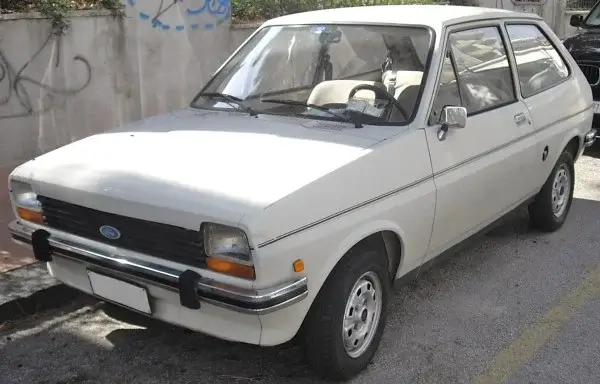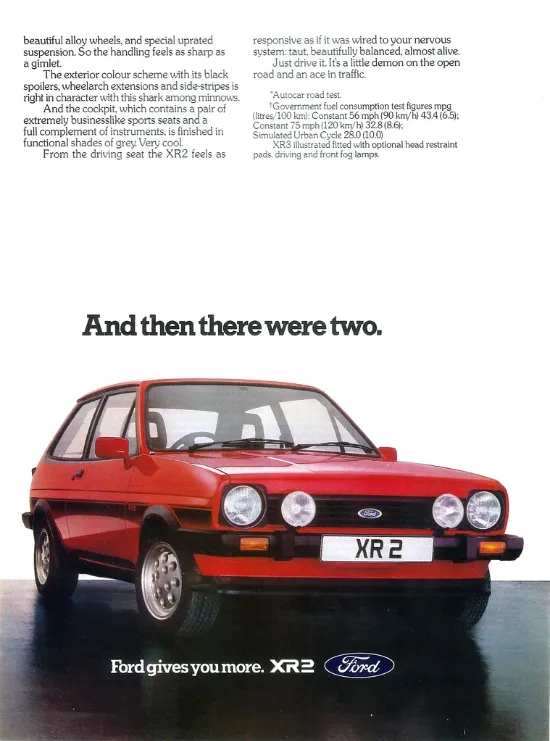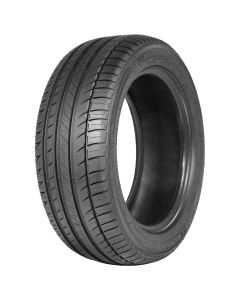Ford Fiesta Tyres
Ford Fiesta 1976–

Ford Fiesta MK1
Mark 1 Ford Fiesta 1976–1983 Tyres
- The MK1 Fiesta 950 Basic fitted 135 - 12 tyres. The only tyre we have in this size is the 135 R 12 Camac NC80. For 135 - 12 tyres the Michelin 12C is the ideal innertube.
- All MK1 Fiesta 950 and 1100 trims and the 1300 GL fitted 145 -12. For this tyre we recommend the 145 - 12 Michelin MX. As for innertubes, we the Michelin 12CG innertube is the correct size.
- The MK1 Fiesta 1300 Ghia and 1300 S fitted 155 - 12. The only tyre we have in this size is the 155 - 12 Nankang. We suggest the Michelin 12D for this tyre.
- The MK1 Supersport fitted 185/60 R13 tyres. We recommend the 185/60 HR 13 Michelin Pilot Exalto PE2 for the Supersport.
Mark 2 and Mark 3 1983–1997 Ford Fiesta Tyres
- The MK2 950 and MK3 1.0 Popular Plus and L models fitted 135 R13 tyres.
- The MK2 1.6D, 1.1, and 1.4 Ghia and the Mk3 LX, Ghia, and 1.8D Fiesta models fitted 155/70 - 13 models fitted 155/70 - 13 tyres.
- The Mk2 1.4S and Mk3 S Fiesta models fitted 165/65 - 13 tyres.
- Unfortunately, no classic tyre manufacturer currently makes a tyre in these sizes.
- The Mk3 Fiesta 1.1 Popular Plus and L fitted 145 - 13, the tyre we recommend in this size is a 145HR13 PIRELLI CINTURATO CA67. This is a great H-speed-rated tyre constructed with specially designed compounds that give the tyre longevity and performance.
- Ford Fiesta enthusiasts often gravitate towards fitting 155 R13 Tyres due to the scarcity of 145R13 options or an inclination for a broader tyre base. If considering the 155R13 size the 155R13 PIRELLI CINTURATO CA67 emerges as the best option.
- For the best experience with a 155R13 innertube, trust in the Michelin 13D.

Ford Fiesta XR2 Advertisement
Ford Fiesta XR2 Tyres
- The MK1, MK2 and MK3 Fiesta XR2 and XR2i fitted 185/60 R13 tyres. This was not a very often used tyre size, the only tyre we currently have in this size is the 185/60 -13 Michelin Pilot Exalto PE2.
- The Pilot Exalto PE2 tyres are fantastic young-timer car tires. This tread is perfect for the brilliant hot hatch cars of the late 80's and 90's thanks to its fantastic road hold and grip, providing sporty handling that is essential for these modern classics.
Fiesta RS Turbo and RS1800 Tyres
- The Fiesta RS Turbo and the RS1800 also fitted 185/55 - 14.
- The 185/55 - 14 Michelin Pilot Exalto PE2 is also a perfect fit for these sporty hatchbacks as a road or competition tyre thanks to the technology used in its design that is based off of competitive use tyres.
Fiesta Zetec S Tyres
- The Fiesta Zetec S fitted 195/50 - 15 tyres. The tyre that we recommend in this size is the 195/50 VR 15 Michelin Pilot Exalto PE2.
Please note - Tyres with a profile below 70% (e.g. 195/50 VR 15 Michelin Pilot Exalto PE2) should not be fitted with innertubes!.

1980 Ford Fiesta Advertisement
Ford Fiesta Innertubes
Ford Fiesta Tyre Pressures
| Generation | Model | Front (Psi) | Rear (Psi) |
|---|---|---|---|
| MK1 | 950 Basic, Popular & Popular Plus | 27 | 27 |
| MK1 | 950 L 1100 L & 1100 Popular Plus | 23 | 26 |
| MK1 | 950 Ghia, 1100 S & 1100 Ghia | 23 | 26 |
| MK1 | 1300 GL, 1300 S & 1300 Ghia | 23 | 26 |
| MK1 | 950 L, 950 GL, 1100 L, 1100 GL & 1100 Ghia | 23 | 26 |
| MK1 | 1100 S, 1300 S, Finesse 950, 1100 & 1300 | 23 | 26 |
| MK1 | Supersport & XR2 | 26 | 26 |
| MK2 | 950, 1100 Popular Plus & L | 26 | 26 |
| MK2 | 1.6D | 27 | 27 |
| MK2 | 1.1 & 1.4 Ghia | 23 | 26 |
| MK2 | XR2 | 26 | 26 |
| MK3 | 1.4S | 23 | 26 |
| MK3 | 1.0, 1.1, Popular & Popular Plus | 26 | 26 |
| MK3 | 1.1L, 1.1LX, Ghia, 1.3LX, SXi, 1.4LX & Ghia | 29 | 26 |
| MK3 | 1.6S | 26 | 26 |
| MK3 | 1.6 XR2i & RS Turbo | 29 | 26 |
| MK3 | 1.8 XR2i & RS 1800 | 29 | 29 |
Ford Fiesta History

Ford Fiesta XR2
The Ford Fiesta received approval for development in 1972 at the start of the supermini explosion in the early 70s, seeing cars like the Renault 5 and Volkswagen Golf become very popular, the demand for small cars with good fuel economy surged following the 1973 Oil Crisis.
The Fiesta was a step outside the norm for Ford, being its second-ever front-wheel-drive car, (The first being the Taunus 12M a decade prior), its first front-wheel-drive car with a transverse engine layout, and also its smallest vehicle to date. The MK1 Supersport was released in 1981 to test the waters for a sportier hatchback, eventually leading to the XR2 being released the following year, easily the most popular version of the Fiesta, with a huge cult following.
The European market was where the Fiesta excelled, it was the ninth best selling vehicle in the UK in its first year and continued to be a hit in the UK until 1982. The United States did not have the same reception of the Fiesta, lasting only three years before the Ford Escort eventually replaced both the Fiesta and Pinto in 1981.
1981 and 1982 were a pivotal couple of years for the Fiesta's growth. Between the US dropping the Escort from its dealerships and a huge new competitor in the UK in the form of the Austin Metro, the Fiesta needed an upgrade. The Fiesta Mk2 debuted in August 1983 with a revised front end, widening the chassis structure, increasing the front track width and new wraparound headlights. Brakes, steering, and carburettors all received upgrades as well. This generation of Fiesta was Ford's best yet, selling over 150,000 models in 1987, finishing second in charts sales, first place went to the Ford Escort.
The Mk3 Fiesta was available in the UK starting April 1989, switching to a very different platform, of a semi-independent torsion beam arrangement, making a big change in the appearance of the car. This generation finally brought about a 5-door hatchback version, something that was wanted in the model lineup for some time, especially since the Opel Corsa and Peugeot 205, two major competitors, had 5-door models in their lineup. The XR2i was released the same year in its 8-valve CVH engine version, with a 16 valve version replacing that in 1996. The RS Turbo was introduced in 1990 but ceased production in 1992 after poor reception surrounding handling, insurance issues, and a large amount of these cars being stolen. The RS Turbo was replaced in 1992 by the RS1800, featuring a 1.8L Zetec engine.



























